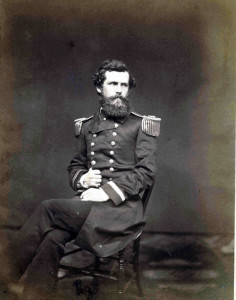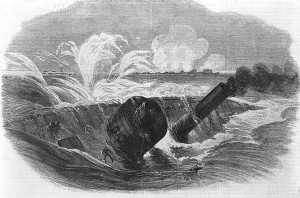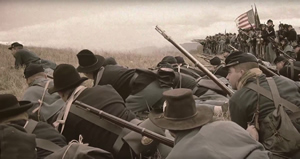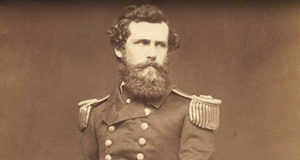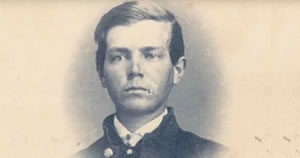[Commander Craven] never made it past that rank but certainly would have had he not been killed in the battle of Mobile Bay under extraordinary circumstances that should have gotten him a Medal of Honor. He was born on 11 January 1813 to Tunis Craven and Hanna Tingey at the Portsmouth, NH Shipyard where his father was stationed as a navy purser and storekeeper. His mother was a daughter of Navy Commodore Thomas Tingey (1750-1820) for whom there may be a record of burial in the Mt. Hope Cemetery at Lambertville, NJ. Tunis’ brother, Thomas T. Craven, would make Rear Admiral in 1866 and go on the retired list three years later. Tunis’ paternal grandfather, Dr. Gershom Craven, had been a Revolutionary War surgeon in the Hunterdon County (NJ) militia. The doctor nursed French General Lafayette back to health at Ringoes within the county. Tunis himself graduated in 1829 from the Partridge School that would become Norwich University and entered the Navy as a midshipman that same year. He served the usual apprenticeship, saw extensive duty on coastal surveys, took part as a Lieutenant in the conquest of the California coast during the War with Mexico, and by 1859 was commanding the steamer Mohawk on patrol off Florida. On the ship he captured four slavers in 1859 and 1860. The most notable of these was the bark Wildfire that had sailed from the Congo with 650 slaves aboard and lost over 100 to death by the time he intercepted and brought them into Key West. In that same year he saved the crew of the foundering Spanish ship Bella for which he received honors from both the Spanish Crown and its insurance firm.
Promoted to Commander in 1861 he sailed briefly in European waters and then took command of the monitor Tecumseh that would join Admiral Farragut’s fleet in the attack on Mobile Bay. With his ship at the head of the column of attack on 5 August 1864 they fired the opening shot of the battle and then struck a mine, sinking bow-down almost immediately and losing 93 men of the 114 onboard. Craven and his pilot were scrambling to get through the small exit of the conning tower atop the turret as the ship lunged. Craven stepped aside, saying “You first, sir.” The fortunate pilot would later recall: “There was nothing after me.” Craven went down with the ship. He was survived by a number of children. In 1838 he had married Miss Mary Cutter of Long Island who died in 1843 leaving three children. He then married Marie Stevenson of Baltimore and set up housekeeping at Bound Brook, New Jersey where the family was still living at the time Craven died. One son, Louis Stevenson Craven, would die in California in 1888. Tunis seemed marked for flag rank had he been fortunate enough to have survived. He would be remembered years later with the commissioning in 1897 of Torpedo Boat No. 10, the T.A.M. Craven, a 147 foot twin-screw steam driven vessel. This boat suffered an equally violent fate when its No. 1 boiler exploded off Georgia in 1913. It did not sink right then but was never repaired and was sunk as a target shortly thereafter. The disposition of Craven’s body is unknown; it may have never been recovered from the sunken monitor.
Re-watch the video:



